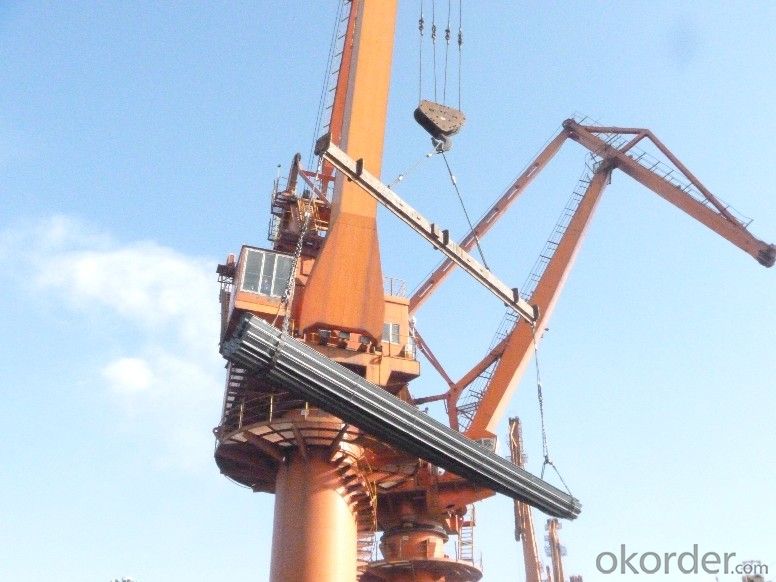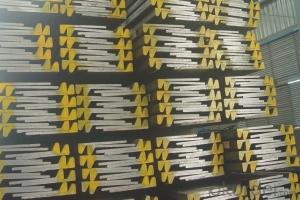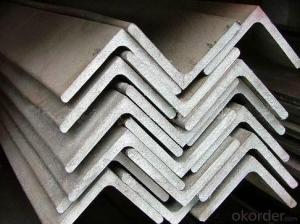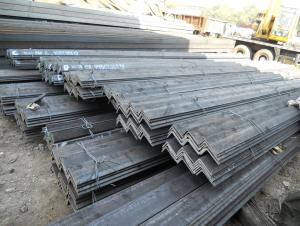Hot Rolled Equal Angle Steel with Many Sizes
- Loading Port:
- Tianjin
- Payment Terms:
- TT or LC
- Min Order Qty:
- 20 m.t.
- Supply Capability:
- 1000 m.t./month
OKorder Service Pledge
OKorder Financial Service
You Might Also Like
Product Description:
OKorder is offering Hot Rolled Carbon Steel Equal Angle at great prices with worldwide shipping. Our supplier is a world-class manufacturer of steel, with our products utilized the world over. OKorder annually supplies products to European, North American and Asian markets. We provide quotations within 24 hours of receiving an inquiry and guarantee competitive prices.
Product Applications:
According to the needs of different structures, Angle can compose to different force support component, and also can be the connections between components. It is widely used in various building structures and engineering structures such as roof beams, bridges, transmission towers, hoisting machinery and transport machinery, ships, industrial furnaces, reaction tower, container frame and warehouse etc.
Product Advantages:
OKorder's Equal Angle are durable, strong, and resist corrosion.
Main Product Features:
· Premium quality
· Prompt delivery & seaworthy packing (30 days after receiving deposit)
· Corrosion resistance
· Can be recycled and reused
· Mill test certification
· Professional Service
· Competitive pricing
Product Specifications:
1. Invoicing on theoretical weight or actual weight as customer request
2. Length: 6m, 9m, 12m as following table
3. Sizes

Sizes: 25mm-250mm | ||
a*t | ||
25*2.5-4.0 | 70*6.0-9.0 | 130*9.0-15 |
30*2.5-6.6 | 75*6.0-9.0 | 140*10-14 |
36*3.0-5.0 | 80*5.0-10 | 150*10-20 |
38*2.3-6.0 | 90*7.0-10 | 160*10-16 |
40*3.0-5.0 | 100*6.0-12 | 175*12-15 |
45*4.0-6.0 | 110*8.0-10 | 180*12-18 |
50*4.0-6.0 | 120*6.0-15 | 200*14-25 |
60*4.0-8.0 | 125*8.0-14 | 250*25 |
4. Payment terms:
1).100% irrevocable L/C at sight.
2).30% T/T prepaid and the balance against the copy of B/L.
3).30% T/T prepaid and the balance against L/C
5.Material details:
Alloy No | Grade | Element (%) | |||||
C | Mn | S | P | Si | |||
Q235 | B | 0.12—0.20 | 0.3—0.7 | ≤0.045 | ≤0.045 | ≤0.3 | |
Alloy No | Grade | Yielding strength point( Mpa) | |||||
Thickness (mm) | |||||||
≤16 | >16--40 | >40--60 | >60--100 | ||||
≥ | |||||||
Q235 | B | 235 | 225 | 215 | 205 | ||
Alloy No | Grade | Tensile strength (Mpa) | Elongation after fracture (%) | ||||
Thickness (mm) | |||||||
≤16 | >16--40 | >40--60 | >60--100 | ||||
≥ | |||||||
Q235 | B | 375--500 | 26 | 25 | 24 | 23 | |
FAQ:
Q1: Why buy Materials & Equipment from OKorder.com?
A1: All products offered byOKorder.com are carefully selected from China's most reliable manufacturing enterprises. Through its ISO certifications, OKorder.com adheres to the highest standards and a commitment to supply chain safety and customer satisfaction.
Q2: How do we guarantee the quality of our products?
A2: We have established an advanced quality management system which conducts strict quality tests at every step, from raw materials to the final product. At the same time, we provide extensive follow-up service assurances as required.
Q3: How soon can we receive the product after purchase?
A3: Within three days of placing an order, we will begin production. The specific shipping date is dependent upon international and government factors, but is typically 7 to 10 workdays.


- Q:Can steel angles be used for storage rack systems?
- Yes, steel angles can be used for storage rack systems. Steel angles are commonly used in the construction of storage rack systems due to their strength and durability. They provide structural support and stability to the racks, allowing them to withstand heavy loads and provide a safe and efficient storage solution. Steel angles can be easily fabricated and installed, making them a popular choice for storage rack systems in various industries such as warehouses, manufacturing facilities, and retail stores. Additionally, steel angles can be customized to meet specific storage requirements, such as adjusting the height or width of the racks. Overall, steel angles are a reliable and cost-effective option for storage rack systems.
- Q:What are the common uses of unequal steel angles?
- Unequal steel angles are commonly used in construction, engineering, and fabrication projects. They are often used as structural supports, providing stability and strength in frameworks, buildings, and bridges. These angles are also used for creating bracing systems, reinforcing corner joints, and as components in machinery and equipment. Additionally, they are utilized in architectural designs for decorative purposes, adding aesthetic appeal to structures.
- Q:How are steel angles tested for quality control?
- Steel angles are tested for quality control using various methods to ensure that they meet the required standards and specifications. One common method is visual inspection, where trained inspectors visually examine the angles for any surface defects, such as cracks, dents, or uneven surfaces. This helps to identify any visible flaws that may affect the structural integrity of the angles. Another method used for quality control testing is dimensional inspection. This involves measuring the dimensions of the angles, such as length, width, and thickness, to ensure they meet the specified tolerances. This is crucial as any deviations from the required dimensions can impact the performance and fit of the angles in various applications. Mechanical testing is also carried out to assess the mechanical properties of the steel angles. This includes tests such as tensile strength, yield strength, and elongation. Tensile strength measures the maximum amount of tensile stress the angle can withstand before breaking, while yield strength indicates the stress at which permanent deformation occurs. Elongation measures the ability of the angle to stretch without fracturing, providing insights into its ductility. In addition, chemical composition analysis is performed to verify that the steel angles contain the correct proportions of alloying elements and impurities. This is done using techniques such as spectrometry, which helps ensure that the steel meets the required chemical composition standards. Furthermore, non-destructive testing methods are used to identify any internal defects or inconsistencies in the steel angles without causing damage. Techniques like ultrasonic testing, magnetic particle testing, and radiographic testing are employed to detect potential flaws such as cracks, voids, or inclusions that might not be visible to the naked eye. Overall, a combination of visual inspection, dimensional inspection, mechanical testing, chemical composition analysis, and non-destructive testing is employed to ensure the quality and integrity of steel angles. These stringent quality control measures help to guarantee that the angles meet the necessary standards and can perform their intended functions safely and reliably.
- Q:How do steel angles contribute to the overall aesthetic of a structure?
- Steel angles can contribute to the overall aesthetic of a structure in several ways. Firstly, their clean and sleek lines can add a modern and contemporary look to the design. The sharp edges and precise angles of steel angles can create a sense of strength and solidity, giving the structure a bold and industrial feel. Additionally, steel angles can be used to create interesting and dynamic shapes within the architecture. Their versatility allows for unique and eye-catching designs, such as cantilevered balconies or intricate lattice patterns. These visually appealing features can become focal points of the structure and enhance its overall aesthetic appeal. Moreover, steel angles can be used to create a sense of rhythm and repetition in the design. By incorporating them in a consistent pattern or arrangement, they can create a visual harmony and balance. This repetition can be particularly effective in large-scale structures, where the steel angles can help break up the monotony of the façade and add visual interest. Furthermore, steel angles can also contribute to the overall durability and longevity of the structure, which in turn enhances its aesthetic value. Steel is known for its strength and resilience, and when used in angles, it can provide structural support and stability. This durability can ensure that the structure remains visually appealing for years to come, without compromising on safety or integrity. Overall, steel angles play a significant role in the aesthetic of a structure, adding a sense of modernity, strength, and versatility. Their clean lines, dynamic shapes, and durability can all contribute to creating a visually appealing and impactful architectural design.
- Q:Can steel angles be used for framing?
- Yes, steel angles can be used for framing in construction projects. Steel angles, also known as angle irons, are L-shaped metal profiles that offer excellent strength and durability. They are commonly used for framing applications due to their structural stability and ability to support heavy loads. Steel angles can be easily cut, welded, and bolted together to create sturdy frames for various structures, including buildings, bridges, and industrial facilities. They are often used as vertical or horizontal supports, bracing elements, or lintels to provide stability and structural integrity. Additionally, steel angles can be galvanized or coated to enhance their corrosion resistance, making them suitable for both indoor and outdoor framing applications. Overall, steel angles are a versatile and reliable choice for framing in construction projects.
- Q:How do you store steel angles to prevent damage?
- To prevent damage and maintain the integrity of steel angles, it is crucial to adhere to certain best practices. Firstly, one must ensure that the storage area remains clean, devoid of any moisture or humidity. The presence of moisture can lead to corrosion and rusting, which can progressively harm the angles. It is highly recommended to store steel angles indoors, in a well-ventilated space, away from direct sunlight and extreme temperature changes. This precautionary measure aids in minimizing the risk of potential damage caused by exposure to natural elements. When stacking steel angles, it is of utmost importance to employ appropriate supports or racks to prevent them from bending or warping under their own weight. Avoiding excessive stacking height is essential, as it can lead to instability and potential accidents. Incorporating pallets or other suitable storage systems can effectively preserve the angles' integrity and reduce the likelihood of damage. Furthermore, it is advisable to separate steel angles of different sizes and types to prevent scratching, chipping, or any other physical damage. Placing protective materials, such as plastic or rubber mats, between layers or individual angles can provide an additional layer of safeguarding. Regular inspections of the storage area play a critical role in identifying any signs of early damage, such as rust spots or deformation. In the event of any issues, addressing them promptly is vital to prevent further deterioration and ensure the quality of the steel angles.
- Q:How do steel angles contribute to the stability of a structure?
- Steel angles contribute to the stability of a structure by providing additional strength and rigidity. They are commonly used to reinforce and support various components, such as beams and columns, by distributing the load and preventing buckling or bending. Their triangular shape allows for efficient weight distribution and helps resist lateral forces, enhancing the overall stability and structural integrity of the building.
- Q:Are steel angles available in different lengths?
- Yes, steel angles are available in different lengths. Steel angles are commonly used in construction and manufacturing industries for various applications such as support structures, frames, and bracing. They are available in a range of standard lengths, typically ranging from 20 feet to 40 feet. However, it is also possible to find steel angles in custom lengths, depending on the specific requirements of a project. Different lengths allow for versatility and flexibility in design and construction, enabling engineers and architects to create structures that meet their specific needs.
- Q:What is the maximum allowable torsional stress for a steel angle?
- Several factors determine the maximum allowable torsional stress for a steel angle, including the specific grade of steel, the dimensions and shape of the angle, and the intended application. Steel angles are commonly used in structural applications, such as supporting beams and frames, and they are designed to withstand various types of stresses, including torsional stress. Engineers typically consult industry standards and codes, such as the AISC Manual or EN 10056, to determine the maximum allowable torsional stress for a steel angle. These standards provide guidelines and formulas for calculating the maximum allowable torsional stress based on properties like the cross-sectional area, moment of inertia, and modulus of elasticity of the steel angle. It is important to note that the maximum allowable torsional stress is usually expressed as a percentage of the steel's yield strength or ultimate tensile strength. This ensures that the angle can safely endure torsional loads without suffering permanent deformation or failure. In practical applications, engineers and designers carefully analyze specific requirements and loading conditions to determine the appropriate maximum allowable torsional stress for a steel angle. They consider factors such as the magnitude and direction of the applied torque, the angle's orientation, and any additional loads or constraints present. Ultimately, the maximum allowable torsional stress for a steel angle is a critical parameter in ensuring the structural integrity and safety of a design. Proper consideration of the steel's properties, industry standards, and specific application requirements is essential for accurate calculations and the selection of an appropriate steel angle capable of effectively resisting torsional stress.
- Q:What are the considerations for selecting the appropriate steel angle finish?
- When selecting the appropriate steel angle finish, there are several considerations that need to be taken into account. One of the primary considerations is the intended use or application of the steel angle. Different finishes offer varying levels of corrosion resistance, which is particularly important in environments where the steel angle will be exposed to moisture or chemicals. For example, a hot-dip galvanized finish provides excellent corrosion resistance and is often preferred for outdoor applications or in environments with high humidity levels. On the other hand, a plain steel finish may be suitable for indoor applications where corrosion resistance is not a major concern. Another consideration is the desired aesthetic appearance. Steel angles can be finished in various ways to achieve different looks. For instance, a mill finish provides a raw, industrial appearance, while a powder coat finish offers a wide range of color options and a more polished look. The choice of finish will depend on the desired aesthetic effect and the overall design of the project. Furthermore, the level of durability required should also be taken into consideration. Some finishes, such as a zinc plating or a stainless steel finish, provide enhanced durability and resistance to wear and tear, making them suitable for heavy-duty applications or areas with high traffic. Conversely, a painted finish may be more prone to chipping or scratching, making it less suitable for applications that require long-term durability. Lastly, cost is an important factor to consider. Different finishes have varying costs associated with them, so it is essential to balance the desired finish with the available budget. It is worth noting that while certain finishes may have a higher upfront cost, they may provide long-term cost savings by reducing maintenance or replacement needs. In conclusion, the selection of the appropriate steel angle finish depends on factors such as corrosion resistance, aesthetic appearance, durability requirements, and budget considerations. By carefully evaluating these considerations, one can choose the most suitable finish that meets both functional and aesthetic needs.
1. Manufacturer Overview |
|
|---|---|
| Location | |
| Year Established | |
| Annual Output Value | |
| Main Markets | |
| Company Certifications | |
2. Manufacturer Certificates |
|
|---|---|
| a) Certification Name | |
| Range | |
| Reference | |
| Validity Period | |
3. Manufacturer Capability |
|
|---|---|
| a)Trade Capacity | |
| Nearest Port | |
| Export Percentage | |
| No.of Employees in Trade Department | |
| Language Spoken: | |
| b)Factory Information | |
| Factory Size: | |
| No. of Production Lines | |
| Contract Manufacturing | |
| Product Price Range | |
Send your message to us
Hot Rolled Equal Angle Steel with Many Sizes
- Loading Port:
- Tianjin
- Payment Terms:
- TT or LC
- Min Order Qty:
- 20 m.t.
- Supply Capability:
- 1000 m.t./month
OKorder Service Pledge
OKorder Financial Service
Similar products
New products
Hot products
Hot Searches
Related keywords































